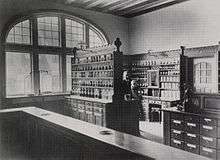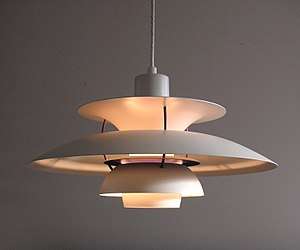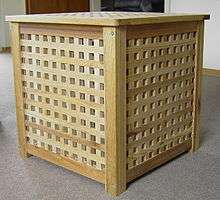Scandinavian design
Scandinavian design is a design movement characterized by simplicity, minimalism and functionality that emerged in the early 20th century, and subsequently flourished in the 1950s throughout the five Nordic countries: Norway, Sweden, Finland, Denmark, and Iceland.

Scandinavian designers are known especially for household goods including furniture, textiles, ceramics, lamps, and glass, but Scandinavian design has been extended to industrial design such as of consumer electronics, mobile phones, and cars.
Overview

In 1914, the Danish Selskabet for Dekorativ Kunst (Company for Decorative Arts) launched its Skønvirke (literally "Graceful Work") magazine. Its title became the name of a new Danish style of arts and crafts, both in objects and in architecture, to rival Art Nouveau and Jugendstil.[1]
From the 1930s, designers such as Alvar Aalto (architecture, furniture, textiles),[2] Arne Jacobsen (chairs),[2] Borge Mogensen (furniture),[2] Hans J. Wegner (chairs),[2] Verner Panton (plastic chairs),[2] Poul Henningsen (lamps),[2] and Maija Isola (printed textiles)[2] helped to create a "golden age of Scandinavian design".[2]
The Lunning Prize, awarded to outstanding Scandinavian designers between 1951 and 1970, was instrumental in making Scandinavian design a recognized commodity, and in defining its profile.[3]
In 1954, the Brooklyn Museum held its "Design in Scandinavia" exhibition, and a fashion for "Scandinavian Modern" furniture began in America.[1][4][5] Scandinavian design is by no means limited to furniture and household goods. It has been applied to industrial design, such as of consumer electronics,[6] mobile phones,[7] and cars.[8]
The concept of Scandinavian design has been the subject of scholarly debate, exhibitions and marketing agendas since the 1950s. Many emphasize the democratic design ideals that were a central theme of the movement and are reflected in the rhetoric surrounding contemporary Scandinavian and international design. Others, however, have analyzed the reception of Scandinavian design abroad, seeing in it a form of myth-making and racial politics.[9]
In the Nordic nations

In Denmark
Danish Design is a style of functionalistic design and architecture that was developed in mid-20th century. Influenced by the German Bauhaus school, many Danish designers used the new industrial technologies, combined with ideas of simplicity and functionalism to design buildings, furniture and household objects, many of which have become iconic and are still in use and production, such as Arne Jacobsen's 1958 Egg chair[10] and Poul Henningsen's 1926 PH-lamps.[11] After the Second World War, conditions in Denmark were ideally suited to success in design. The emphasis was on furniture but architecture, silver, ceramics, glass and textiles also benefitted from the trend. Denmark's late industrialisation combined with a tradition of high-quality craftsmanship formed the basis of gradual progress towards industrial production.[12]

In Finland
Finnish design spans clothing, engineering design, furniture, glass, lighting, textiles, and household products.[13] The "Design from Finland" mark was created in 2011.[14] Finland's Design Museum (formerly called the Museum of Art and Design) has a collection founded in 1873, while Helsinki's University of Art and Design, established in 1871, now forms part of Aalto University.[15]
Prominent Finnish designers include Alvar Aalto (vases, furniture),[16] Aino Aalto (glassware),[16] Kaj Franck (glass, tableware),[16] Klaus Haapaniemi (fabric prints),[16] Simo Heikkilä (furniture),[17] Kristina Isola (textiles),[16] Maija Isola (Marimekko prints),[16] Harri Koskinen (glass, homeware),[16] Mika Piirainen (clothing, accessories),[16] Timo Sarpaneva (glass, homeware),[16] Oiva Toikka (glass art),[16] Tapio Wirkkala (glass art, glassware),[16] Eero Aarnio (plastic furniture),[16] Sanna Annukka (screenprints),[16] Anu Penttinen (glass),[16] Aino-Maija Metsola (textiles, homeware),[16] and Maija Louekari (tableware, homeware).[16]
.jpg)
In Iceland
Design in Iceland is a relatively young tradition, starting in the 1950s but now growing rapidly. The country's limited options for manufacturing and its constrained choice of materials have both forced designers to be innovative, though wool remains a staple material, whether felted or knitted. Iceland's Museum of Design and Applied Art, aiming to record Icelandic design from 1900 onwards, opened in 1998.[18] The Iceland Academy of the Arts was also founded in 1998, soon followed by its Faculty of Architecture and Design, which has promoted a distinctively Icelandic character in the nation's design.[19]
.jpg)
In Norway
Norwegian design has a strong minimalist aesthetic.[20] Designed items include lamps and furniture. Qualities emphasised include durability, beauty, functionality, simplicity, and natural forms.[21]
The Norwegian Centre for Design and Architecture, "DogA", is housed in a former transformer station in Oslo.[22] Norway holds an annual design exhibition called "100% Norway" at the London Design Fair.[23][24]
Prominent Norwegian furniture designers include Hans Brattrud,[25] Sven Ivar Dysthe,[26] Olav Eldøy,[27] Olav Haug,[28] Fredrik A. Kayser,[29] and Ingmar Relling.[30]

In Sweden
Swedish design is considered minimalist, with an emphasis on functionality and simple clean lines. This has applied especially to furniture. Sweden is known for traditional crafts including glass and Sami handicrafts. Swedish design was pioneered by Anders Beckman (graphics),[31] Bruno Mathsson (furniture),[32] Märta Måås-Fjetterström[32] and Astrid Sampe (textiles),[32] and Sixten Sason (industrial).[32] Organisations that promote design in Sweden are Svensk Form, the Swedish society of crafts and design, founded in 1845; the Swedish Industrial Design Foundation, known as SVID; the Swedish Arts Council; and the Swedish Centre for Architecture and Design (known as ArkDes) on the island of Skeppsholmen in Stockholm, beside the modern art museum.[32]
References
- Rekkali, Zeynep. "Danish Design: The birth, rise, fall and resurrection". Danish. Retrieved 3 January 2018.
- "Scandinavian design". Scandinavia design. Retrieved 3 January 2018.
- Krondahl, Hans. "Tema Lunning Prize winners". Runeberg. Retrieved 3 January 2018.
- Englund, Schmidt & Wood 2007.
- Halén & Wickman 2003.
- Ingdal, Cecilie. "Let there be light". Bang & Olufsen. Retrieved 3 January 2018.
- "The new old principles of HMD's #Nokia design". Nokia. 15 August 2017. Retrieved 3 January 2018.
- Green, Gavin. "Designed to Delight". Volvo. Retrieved 3 January 2018.
- Leary, Erin (2015). "'The Total Absence of Foreign Subjects': The Racial Politics of US Interwar Exhibitions of Scandinavian Design". Design and Culture. 7 (3): 283–312.
- "Egg Chair". Aram. Retrieved 31 December 2017.
- "The PH lamp". Visit Denmark. Archived from the original on 2012-02-15.
- "Furniture and Industrial Design" (PDF). Ministry of Foreign Affairs, Denmark. Retrieved 17 December 2008.
- "Brand Stories". Finnish Design. Retrieved 7 May 2014. Information from pages on each artist on that website.
- "About". Design from Finland. Retrieved 3 January 2018.
- "Welcome to Finland, the design nation". This is Finland. Retrieved 3 January 2018.
- "Finnish Designers". Finnish Design. Retrieved 7 May 2014. Information from pages on each artist on that website.
- Houseley, Laura and Ahtisaari, Marko editors (2014). Out of the Blue: the Essence and Ambition of Finnish Design, p. 113. Gestalten, Berlin. ISBN 978-3-89955-457-1.
- "Design and Architecture | General information". Iceland Design Centre. Retrieved 1 January 2018.
- "Iceland Design Centre". Iceland Design Centre. Retrieved 1 January 2018.
- "Design: Where nature meets minimalism". Visit Norway. Retrieved 4 January 2018.
- Danner, Christi (22 May 2014). "10 Reasons Norwegian Design Is Awesome". Complex. Retrieved 4 January 2018.
- "The DOGA building". Design og arkitektur Norge. Retrieved 8 April 2018.
- "Norwegian Design Now". 100percentnorway. Retrieved 4 January 2018.
- "Norwegian Arts". Norwegian Arts. Retrieved 4 January 2018.
- Linder, Mats. "Hans Brattrud". In Godal, Anne Marit (ed.). Store norske leksikon (in Norwegian). Oslo: Norsk nettleksikon. Retrieved 8 August 2019.
- Christiansen, Solveig Lønne. "Sven Ivar Dysthe". In Helle, Knut (ed.). Norsk biografisk leksikon (in Norwegian). Oslo: Kunnskapsforlaget. Retrieved 8 August 2019.
- "Products by Olav Eldøy". Architonic. Retrieved 8 August 2019.
- "ELVERUM MØBEL- OG TREVAREFABRIKK – MØBELREKLAME" (in Norwegian). Matslinder. 2 March 2018.
- Henriksen, Petter, ed. (2007). "Fredrik A. Kayser". Store norske leksikon (in Norwegian). Oslo: Kunnskapsforlaget. Retrieved 31 March 2009.
- Lade (1991). Møbeldesigneren Ingmar Relling i perspektiv (in Norwegian). City: Sykkylven Næringsutvikling A/S. ISBN 978-82-992499-0-4. OCLC 474491579.
- Kokborg, Heidi. "Everything there is to know about modern Scandinavian design". Scan magazine. Retrieved 8 August 2019.
- "Stylish functionality". Sweden.se. Retrieved 1 January 2018.
Books
- Bolander, Lars; MacIssac, Heather (2010). Lars Bolander's Scandinavian Design. Harry N Abrams.
- Ehmann, Sven (2016). Scandinavia dreaming : Nordic homes, interiors and design. Berlin: Gestalten.
- Englund, Magnus; Schmidt, Chrystina; Wood, Andrew (2007). Scandinavian Modern. Ryland Peters & Small.CS1 maint: ref=harv (link)
- Fallan, Kjetil (2012). Scandinavian Design: Alternative Histories. Berg.
- Fiell, Charlotte J; Fiell, Peter (2005). Scandinavian Design. Taschen.
- Gura, Judith (2012). Sourcebook of Scandinavian Furniture, Designs for the 21st Century. Norton.
- Hard af Segerstad, Ulf (1961). Scandinavian Design (Nordisk Nyttokonst). Nordisk Rotogravyr.
- Halén, Widar; Wickman, Kerstin (2003). Scandinavian Design Beyond the Myth. Arvinius.CS1 maint: ref=harv (link)
- Nelson, Katherine E; Cabra, Raul (2004). New Scandinavian Design. Chronicle Books.
- Oriol, Anja Llorella (2005). Asensio, Paco (ed.). New Scandinavian Design. teNeues.
- Sommar, Ingrid (2005). Scandinavian Style. Carlton.
- Wickman, Kerstin (1996). Scandinavian Design: the dream is still alive. Swedish Information Service.
- Zahle, Erik (1961). A Treasury of Scandinavian Design. Golden Press.